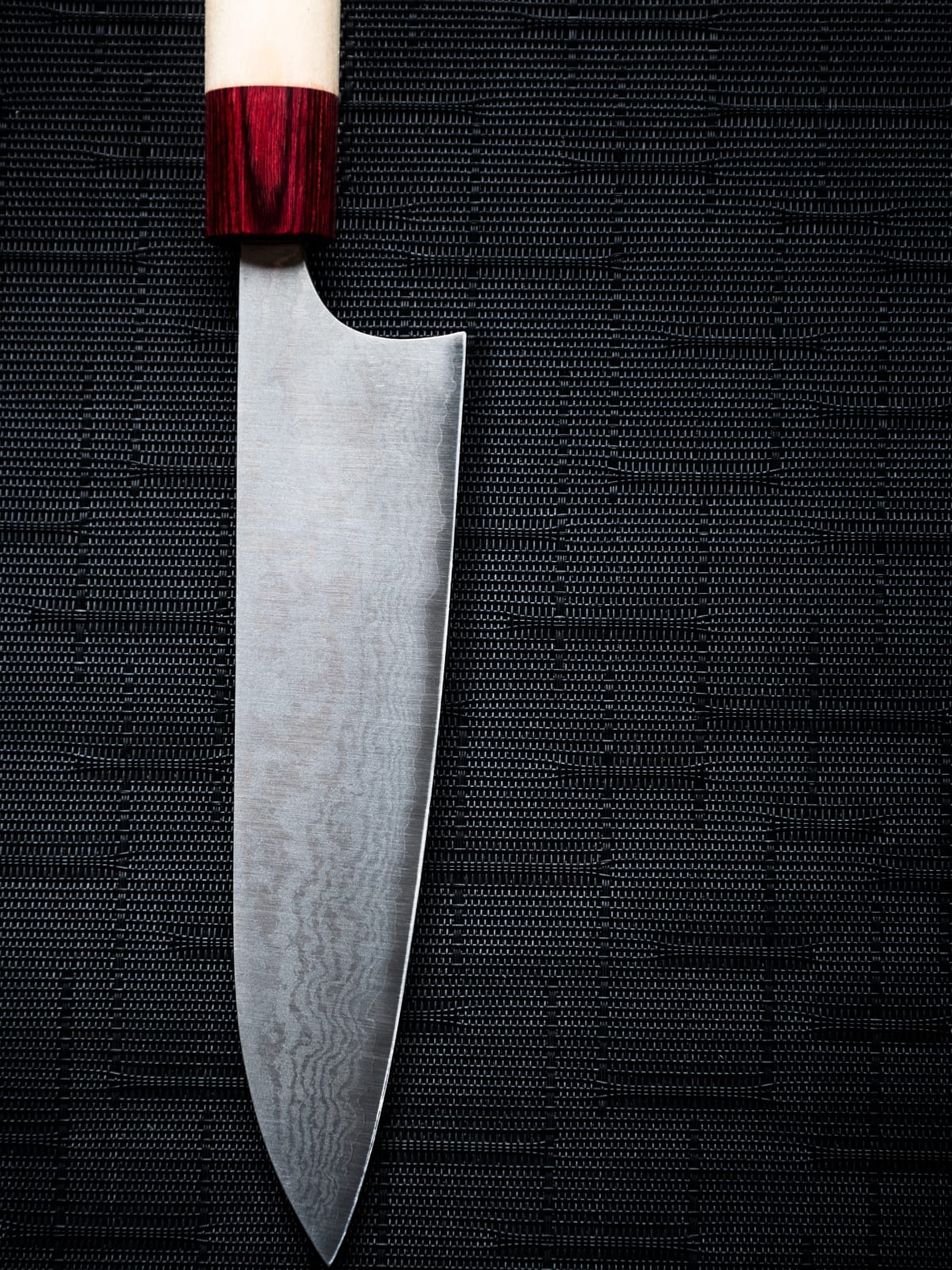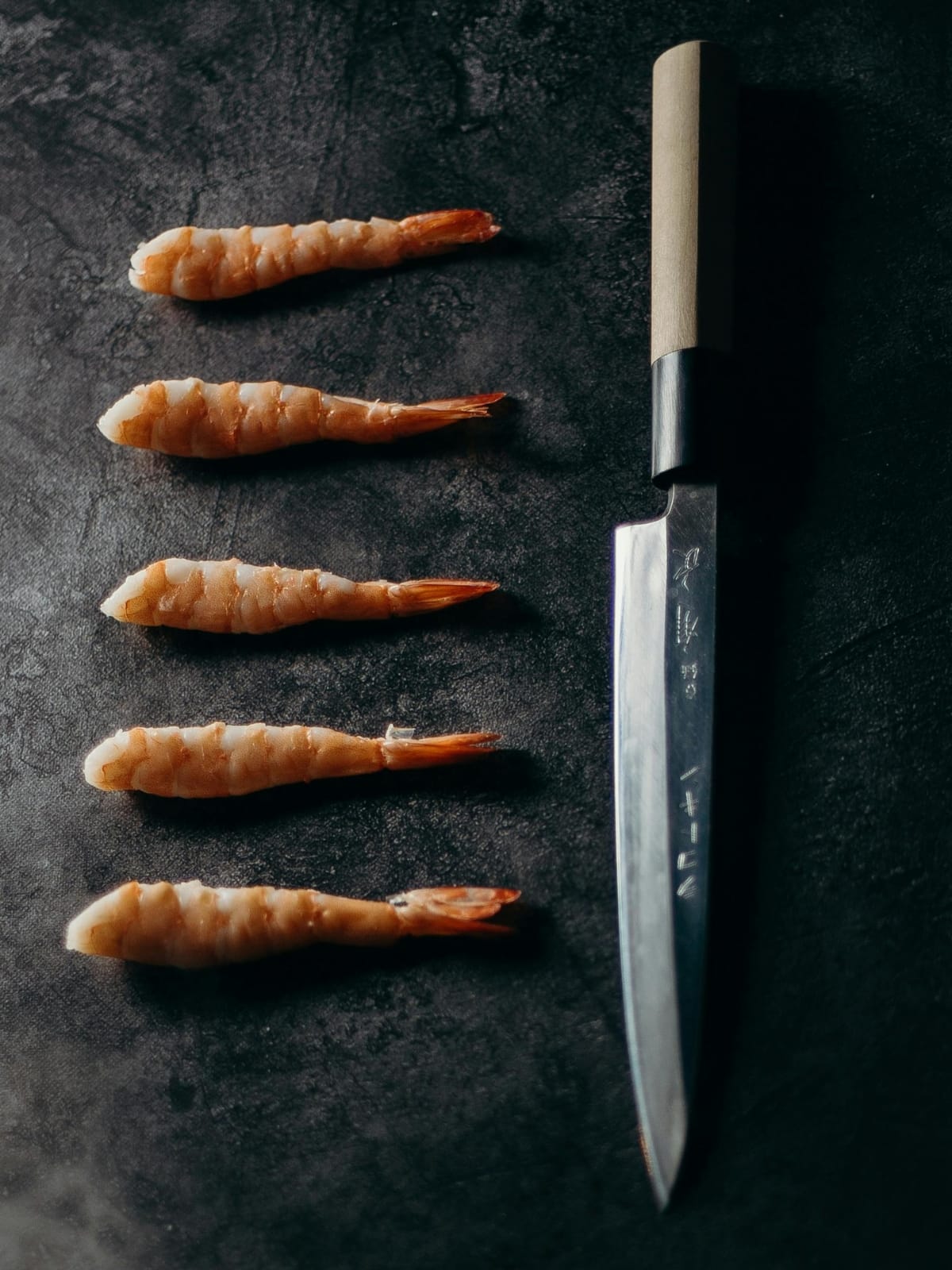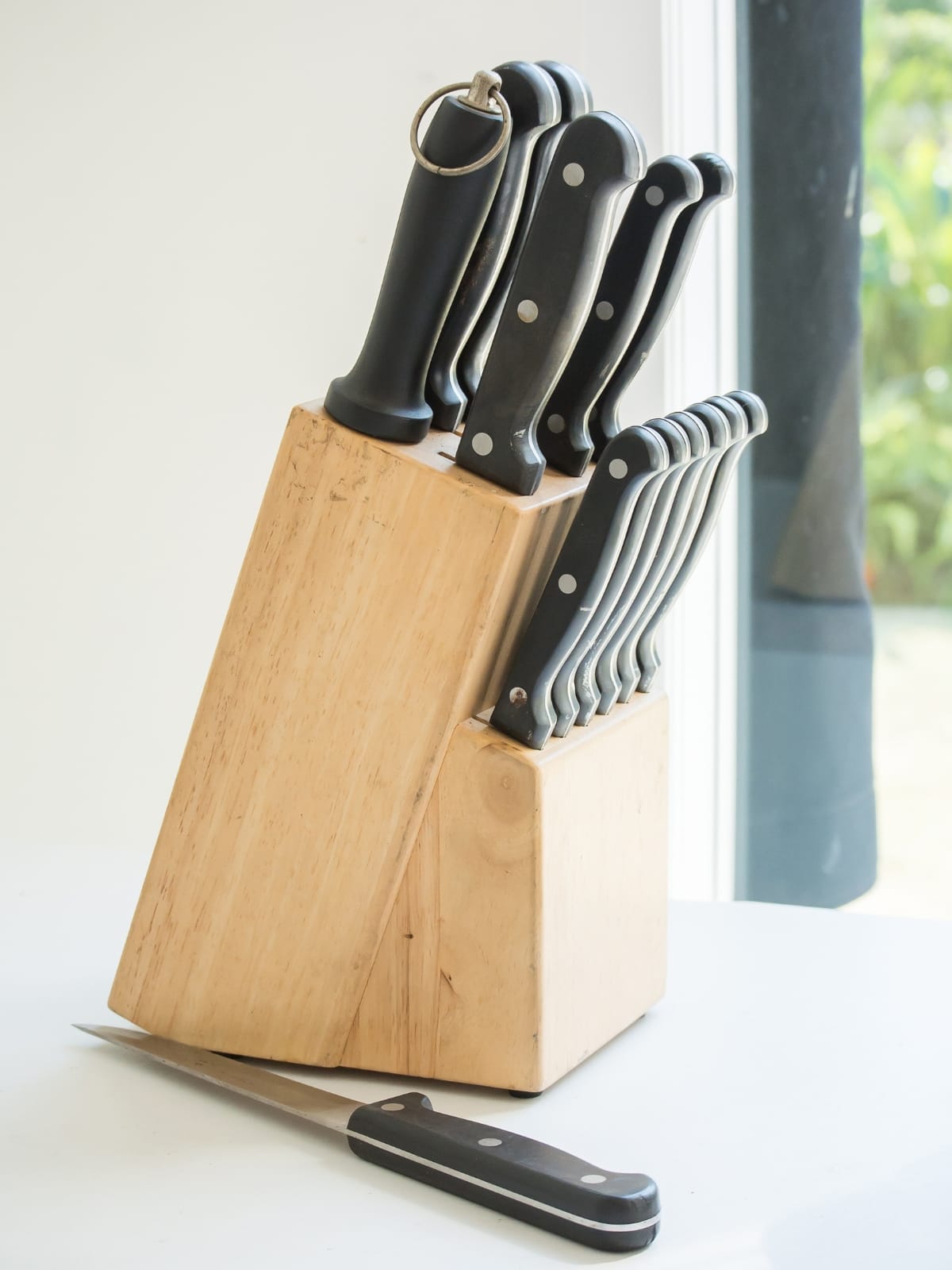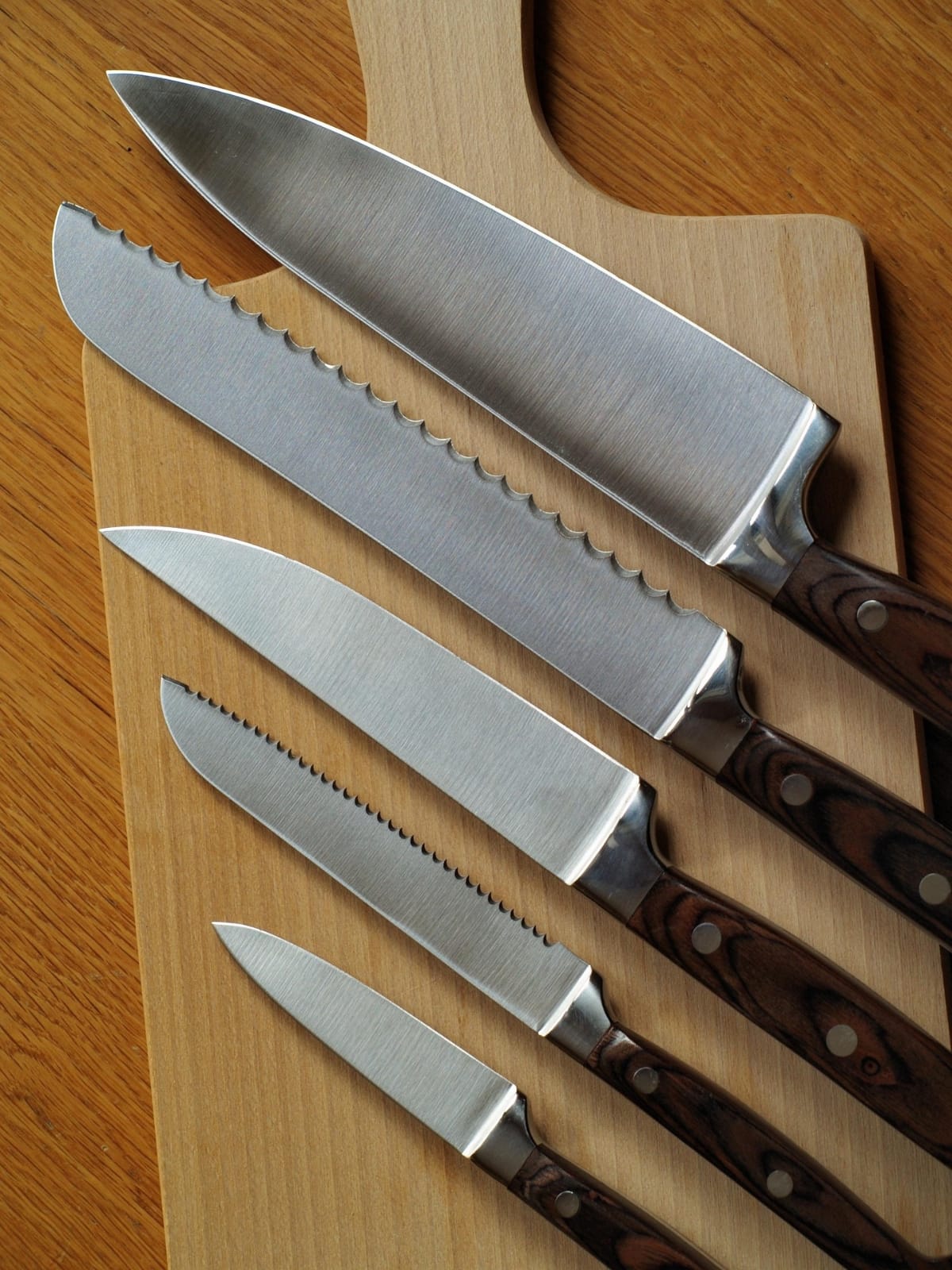As a stay-at-home mom and passionate home cook, I’ve learned that having the right tools in the kitchen can make all the difference. Over the years, I’ve experimented with various kitchen knives, but nothing has revolutionized my cooking experience quite like investing in a high-quality Japanese kitchen knife set. In this comprehensive guide, I’ll share my journey and insights to help you find the perfect Japanese knife set for your home kitchen.
Understanding Japanese Kitchen Knives
Before we dive into the specific sets, let’s talk about what makes Japanese knives so special. Unlike their Western counterparts, Japanese knives are known for their exceptional sharpness, precision, and craftsmanship. They’re typically made with harder steel, allowing for a thinner, sharper edge that stays sharp longer.
Japanese knives come in various types, each designed for specific tasks:
- Gyuto (Chef’s knife): An all-purpose knife for slicing, dicing, and chopping
- Santoku: A general-purpose knife for vegetables, fish, and meat
- Nakiri: Specialized for cutting vegetables
- Petty: A small utility knife for precise tasks
- Sujihiki: A long, thin knife for slicing fish and meat
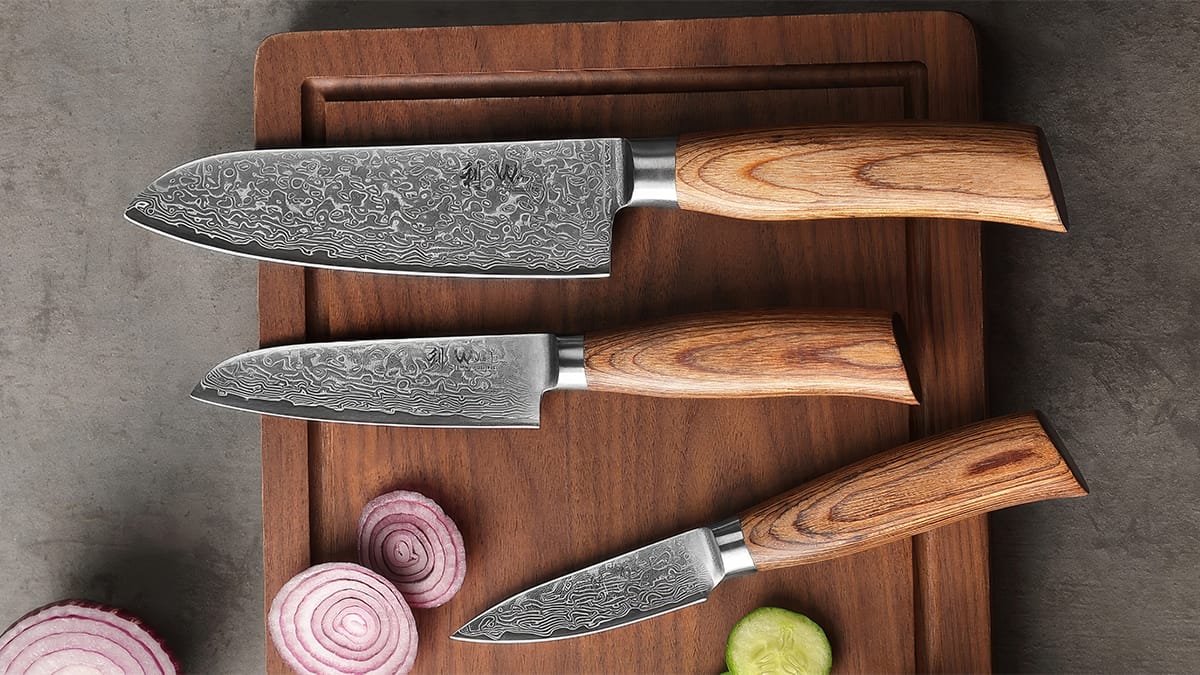
The materials used in Japanese knife-making are crucial to their performance. High-carbon stainless steel is common, offering a balance of sharpness, durability, and ease of maintenance. Some high-end knives use specialized steels like VG-10 or ZDP-189 for even better edge retention and corrosion resistance.
One key factor in Japanese knives is their hardness, measured on the Rockwell scale. Most Japanese knives fall between 58-65 HRC, compared to Western knives which typically range from 52-56 HRC. This higher hardness allows for a sharper edge but can also make the knives more brittle if not handled properly.
If you’re new to Japanese knives, you might want to start by familiarizing yourself with the basic Japanese kitchen knives before diving into a full set. This will help you understand the unique features and purposes of each knife type.
Why Every Home Cook Should Consider a Japanese Knife Set
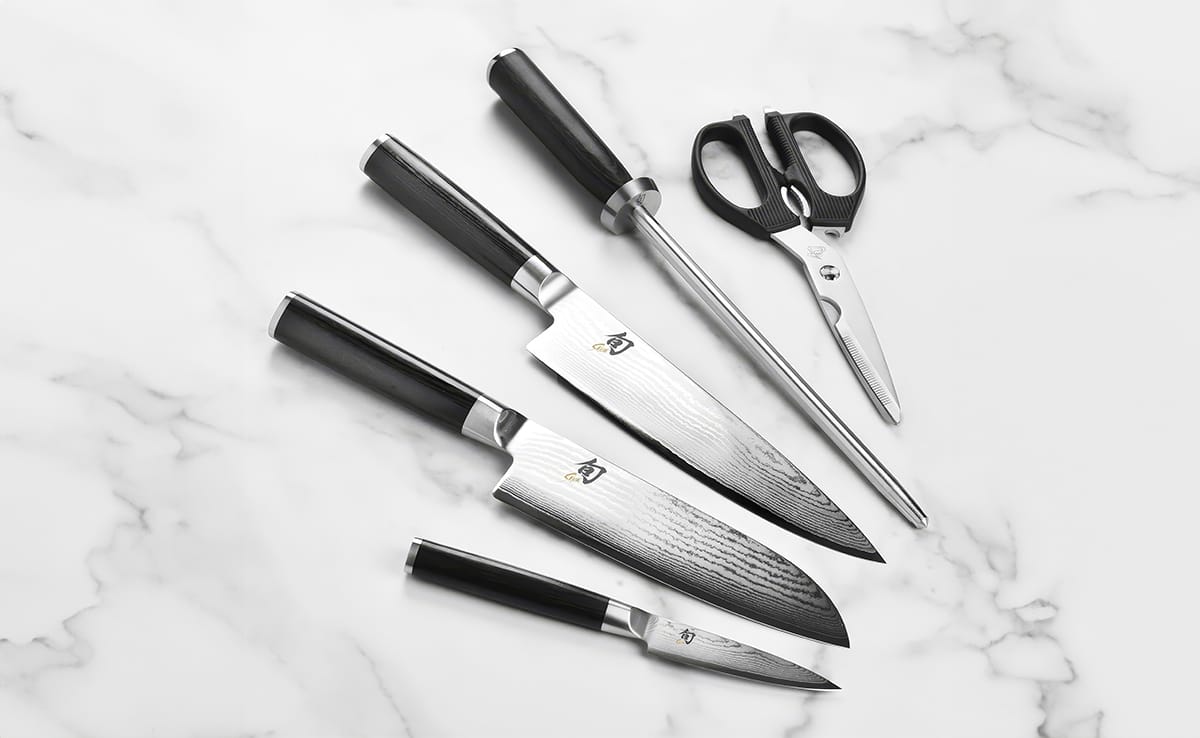
As a busy mom, I can’t stress enough how much a good Japanese knife set has improved my cooking experience. Here’s why I think every home cook should consider investing in one:
- Superior Sharpness and Precision: The razor-sharp edges of Japanese knives make prep work a breeze. I can slice through tomatoes without squishing them and chop onions with minimal tears!
- Longevity and Durability: While they require proper care, Japanese knives can last a lifetime. I see my set as an investment in my cooking future.
- Versatility in the Kitchen: From delicate herb chopping to tough squash cutting, a good Japanese knife set can handle it all.
- Aesthetic Appeal: Let’s be honest, these knives are beautiful. They make me feel like a professional chef every time I use them!
Top 5 Japanese Kitchen Knife Sets for Stay-at-Home Moms
After extensive research and personal experience, I’ve narrowed down the top 5 Japanese kitchen knife sets that I believe offer the best value for stay-at-home moms:
- Global Classic 3 Piece Knife Set
- Shun Classic 6-piece Slim Knife Block Set
- Miyabi Koh 7-pc Knife Block Set
- Tojiro DP 8-piece Slim Knife Block Set
- MAC Knife Professional series 2-piece starter knife set
Let’s dive into each of these sets in detail.
1. Global Classic 3-piece Knife Set
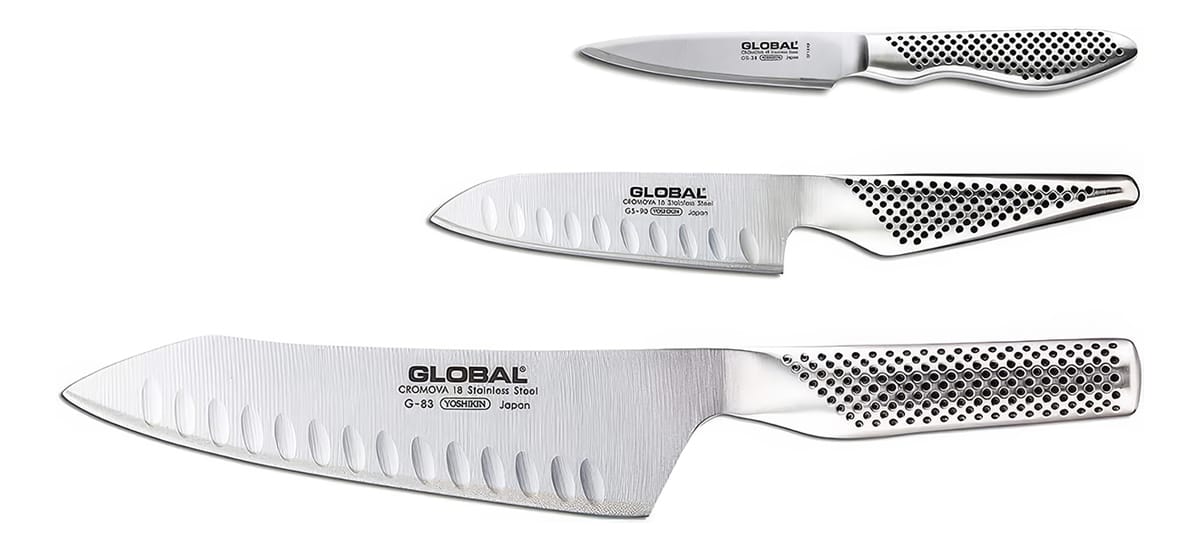
Overview and First Impressions
When I first unboxed the Global Classic 3 Piece Knife Set, I was immediately struck by its sleek, modern design. The all-metal construction gives these knives a unique look that stands out in the kitchen.
Key Features and Specifications
- Includes 7″ Chef’s Knife, 5″ Santoku Knife, and 3.5″ Paring Knife
- Made from CROMOVA 18 high-carbon stainless steel
- Hollow handles filled with sand for perfect balance
- Seamless construction for hygiene and easy cleaning
- Exceptionally sharp edge at a 15° angle
- Lightweight design
My Experience
Using these knives has been a joy. The lightweight design makes long prep sessions less tiring, and the balance is impeccable. The chef’s knife has become my go-to for most tasks, while the santoku is perfect for vegetables and the paring knife handles detailed work beautifully.
Pros
- Extremely sharp and stays sharp for a long time
- Lightweight and well-balanced
- Easy to clean and maintain
- Modern, minimalist aesthetic
Cons
- The all-metal handle can be slippery when wet
- Some may find the lightweight design takes getting used to
Price Point and Value for Money
At $199.95, this set is an excellent entry point into high-quality Japanese knives. The versatility of the three knives makes it a great value for the price.
Who This Set is Best Suited For
This set is perfect for the home cook who wants to upgrade their kitchen tools without breaking the bank. It’s especially good for those who appreciate modern design and don’t mind a bit of a learning curve with the lightweight knives.
2. Shun Classic 6-piece Slim Knife Block Set
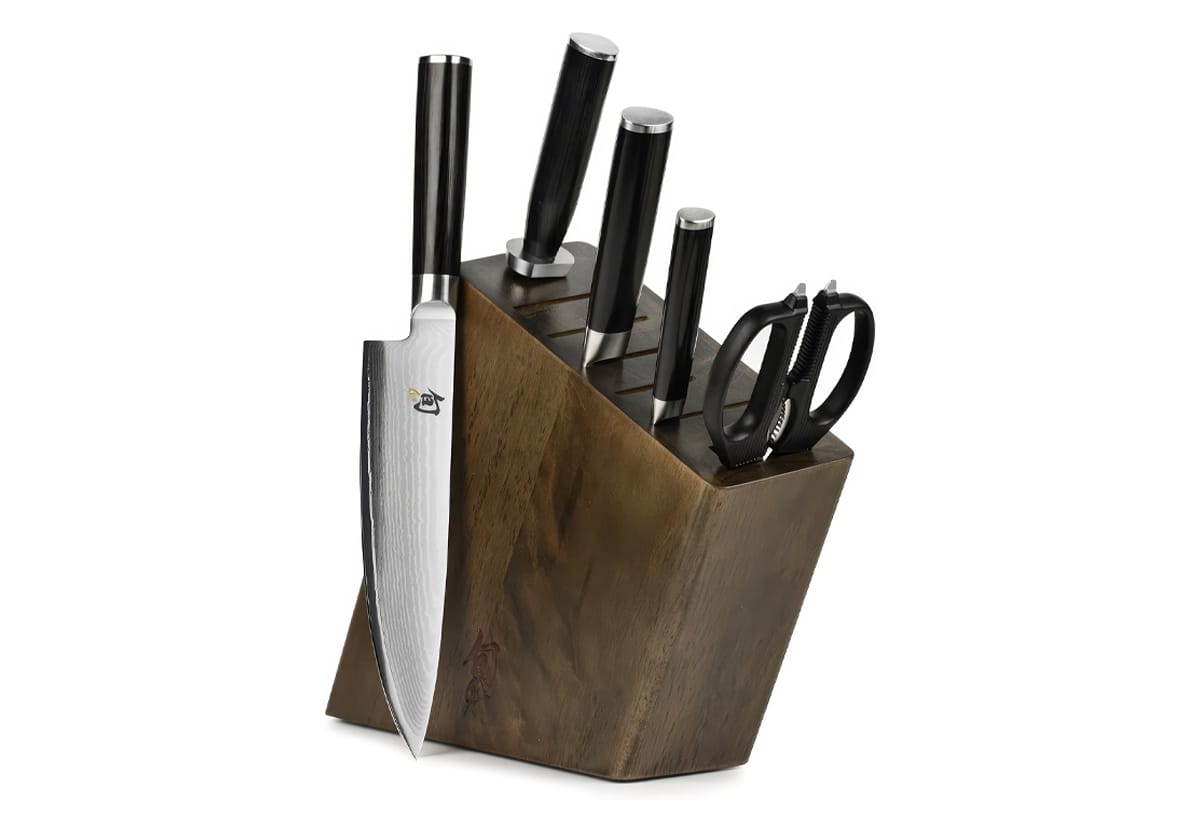
Overview and First Impressions
The Shun Classic set immediately impresses with its beautiful Damascus-patterned blades and elegant dark wood block. It feels like bringing a piece of Japanese craftsmanship into your kitchen.
Key Features and Specifications
- Includes 3.5″ Paring Knife, 7″ Santoku Knife, 8″ Chef’s Knife, 9″ Combination Honing Steel, Kitchen Shears, and 8-slot Slim Design Dark Wood Knife Block
- VG-MAX cutting core with 34 layers of stainless Damascus cladding
- D-shaped PakkaWood handle
- Handcrafted in Seki, Japan
- 16° double-bevel blade angle
My Experience
These knives are a dream to use. The VG-MAX steel core holds an incredibly sharp edge, and the Damascus cladding not only looks beautiful but also helps food release easily from the blade. The D-shaped handle fits comfortably in my hand, reducing fatigue during long cooking sessions.
Pros
- Exceptional sharpness and edge retention
- Beautiful aesthetics
- Comfortable and durable handle
- Comprehensive set with essential tools
Cons
- Higher price point
- Requires careful maintenance to preserve the blade’s appearance
Price Point and Value for Money
At $383.95, this set is a significant investment. However, the quality, performance, and comprehensive nature of the set make it worth considering for serious home cooks.
Who This Set is Best Suited For
This set is ideal for the home chef who values both performance and aesthetics. It’s a great choice for those ready to invest in high-quality knives that will last a lifetime with proper care.
3. Miyabi Koh 7-piece Knife Block Set
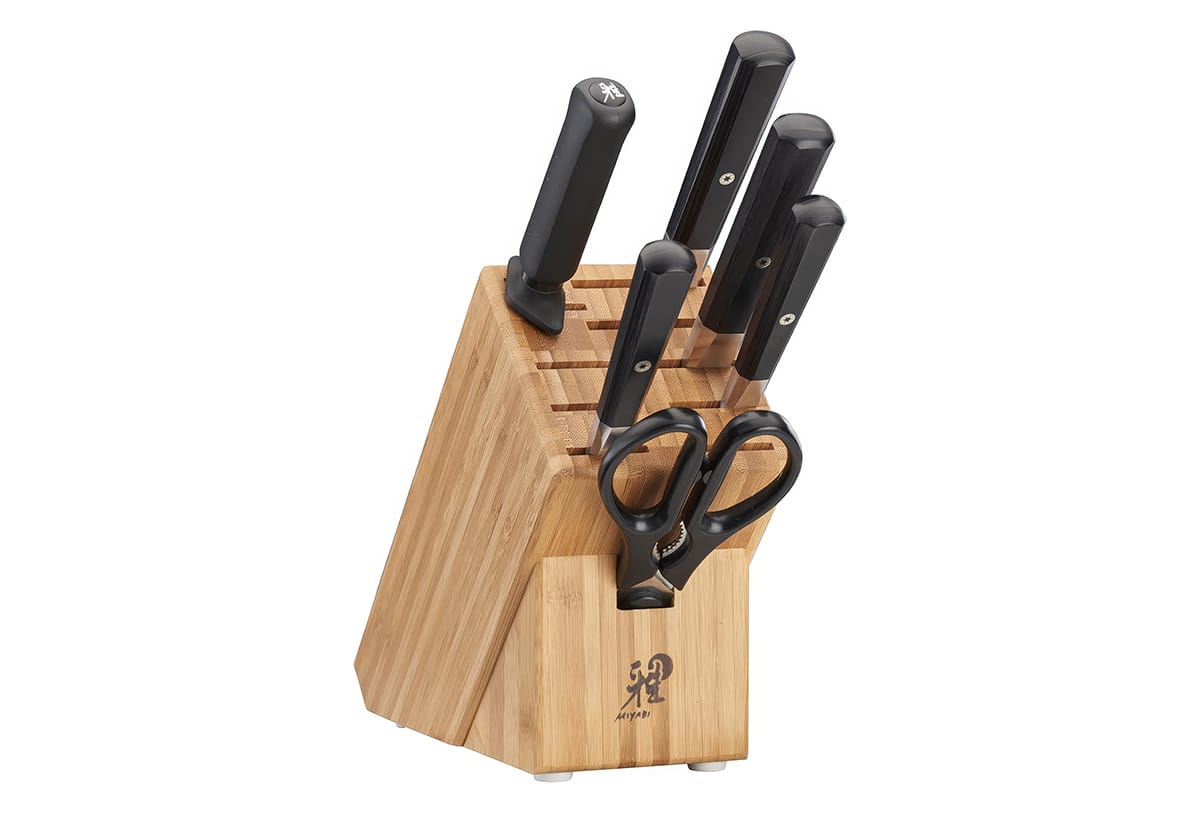
Overview and First Impressions
The Miyabi Koh set strikes a balance between traditional Japanese knife-making and modern German engineering. The simple yet elegant design of these knives caught my eye immediately.
Key Features and Specifications
- Set includes: 3.5″ Paring Knife, 5.5″ Santoku, 8″ Chef’s Knife, 9″ Bread Knife, Kitchen Shears, 9″ Sharpening Steel, 10 Slot Bamboo Block
- FC61 fine carbide stainless steel with 61 Rockwell hardness
- Ice-hardened FRIODUR blade for durability and corrosion resistance
- Hand-honed Honbazuke edge
- Octagon-shaped Pakkawood handle
My Experience
These knives offer an excellent balance of sharpness and durability. The ice-hardening process really does seem to improve edge retention – I’ve found I need to sharpen these less often than other knives I’ve used. The octagon-shaped handle is comfortable and provides a secure grip.
Pros
- Excellent edge retention
- Comfortable and secure handle
- Comprehensive set including a bread knife
- Combines Japanese tradition with German engineering
Cons
- Higher price point
- May be overkill for casual cooks
Price Point and Value for Money
At $529.95, this is the most expensive set in our lineup. However, the combination of traditional craftsmanship and modern technology justifies the price for those who can afford it.
Who This Set is Best Suited For
This set is perfect for the serious home cook or aspiring chef who wants a comprehensive set of high-performance knives. It’s also great for those who appreciate the fusion of Japanese and German knife-making traditions.
4. Tojiro DP 8-piece Slim Knife Block Set
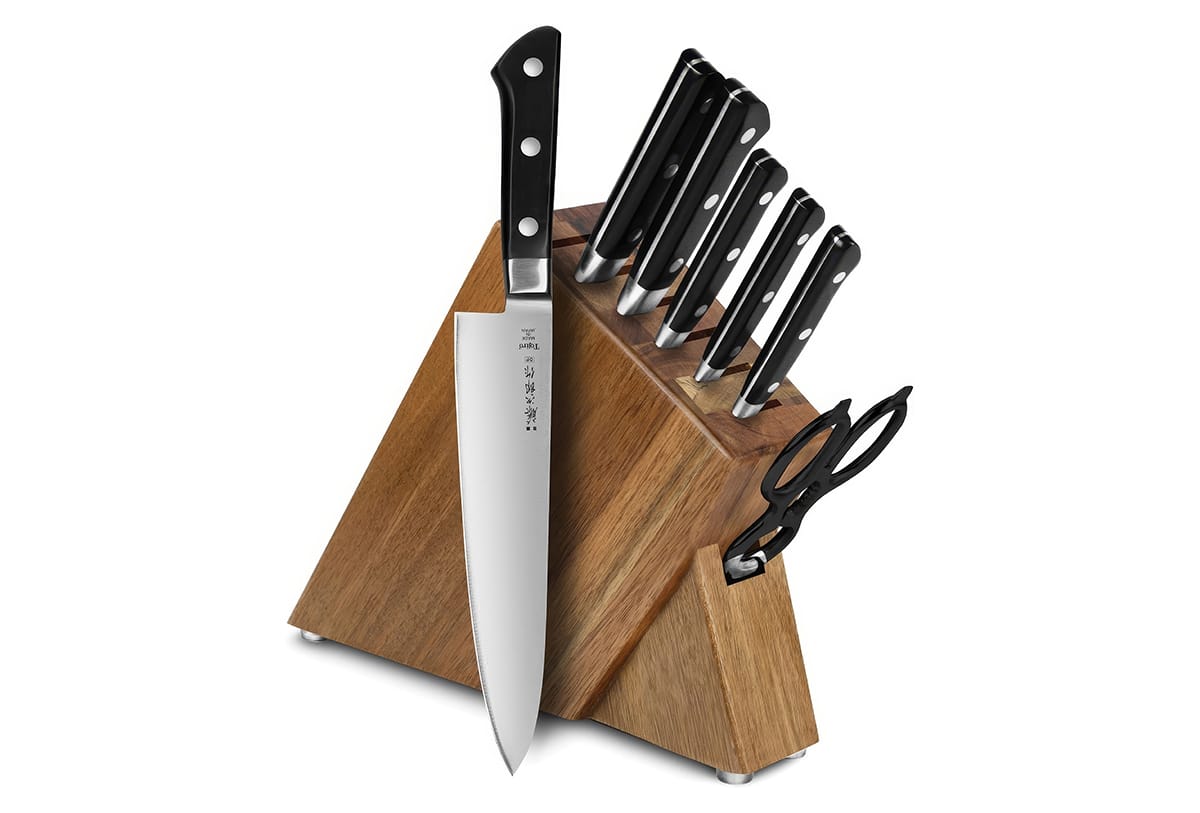
Overview and First Impressions
The Tojiro DP set impressed me with its professional appearance and the included Acacia wood block. These knives look and feel like they belong in a professional kitchen.
Key Features and Specifications
- 8-piece set including knives and an Acacia wood block
- Full-tang construction
- 3-ply clad construction with VG-10 super steel core
- 60 Rockwell Hardness
- 9 to 12° blade angle
- Triple riveted Micarta handle with bolster
My Experience
These knives perform exceptionally well. The VG-10 core provides excellent edge retention, while the full-tang construction gives them a solid, well-balanced feel. The Micarta handles are comfortable and provide a secure grip even when wet.
Pros
- Excellent sharpness and edge retention
- Durable construction
- Comfortable and secure handles
- Professional-grade performance
Cons
- Some users noted that the knife block may not match the quality of the knives
- Requires careful maintenance
Price Point and Value for Money
While the exact price wasn’t provided, this set is positioned as a high-end, professional-grade option. Given the quality of materials and construction, it likely offers good value for serious cooks.
Who This Set is Best Suited For
This set is ideal for home cooks who want professional-grade tools and are willing to invest in and properly maintain high-quality knives.
5. MAC Knife Professional series 2-piece starter knife set
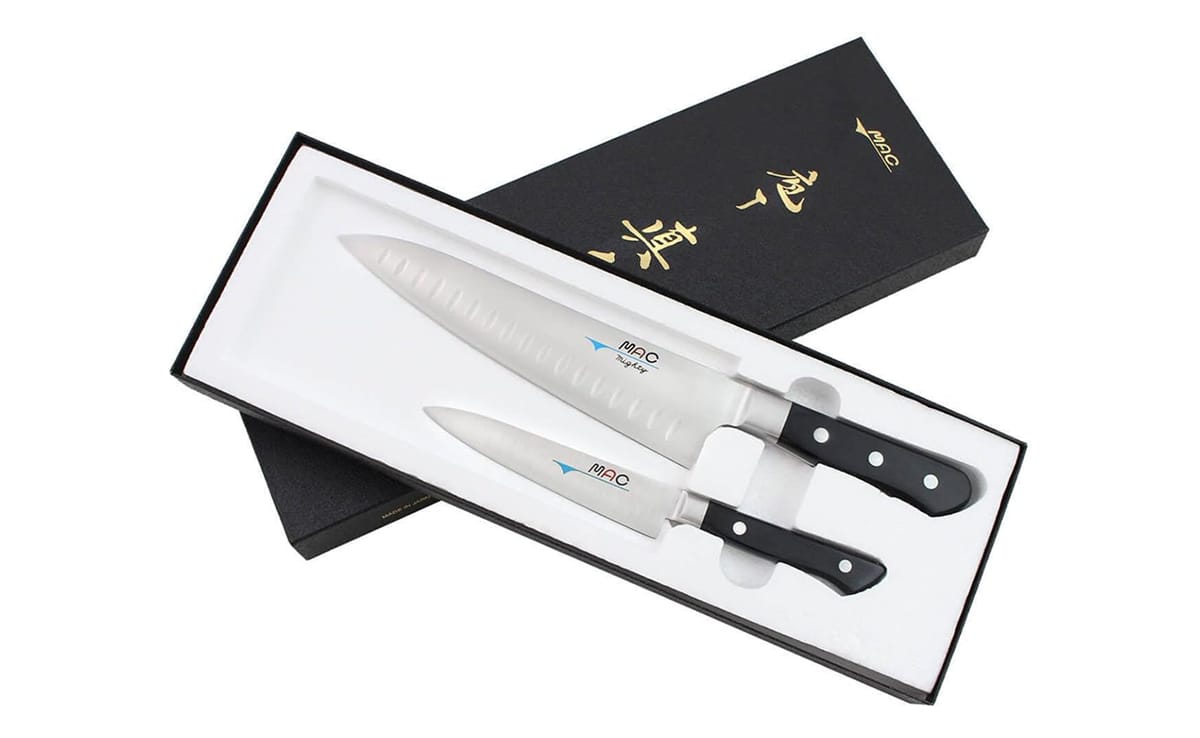
Overview and First Impressions
The MAC Knife set, while the smallest in our lineup, immediately impressed me with its reputation for sharpness and quality. The sleek design and promise of professional-grade performance were intriguing.
Key Features and Specifications
- Includes MTH-80 Pro series 8″ Chef’s knife with dimples and PKF-50 Pro series 5″ Paring knife
- High-carbon, stain-resistant, molybdenum steel blades
- 15-degree double-bevel edge
- Bolstered handles for better weight distribution
- Sub-zero tempered alloy in Chef’s knife
- Pakkawood handles
My Experience
These knives live up to their reputation for sharpness. The chef’s knife, in particular, is a joy to use – the dimpled edge really does help prevent food from sticking. Despite being only a two-piece set, I found these knives could handle most of my daily cooking tasks with ease.
Pros
- Exceptional sharpness
- Excellent edge retention
- Comfortable and well-balanced
- Dimpled edge on chef’s knife prevents food sticking
Cons
- Only includes two knives
- Requires proper care and maintenance
Price Point and Value for Money
At $209.95, this set offers excellent value for those who prioritize quality over quantity. The performance of these two knives can easily outshine larger sets of lower quality.
Who This Set is Best Suited For
This set is perfect for the home cook who wants professional-grade tools but doesn’t need a large set. It’s also great for those who prefer to build their knife collection piece by piece, starting with the essentials.
Comparison Table
| Feature | Global Classic 3-piece | Shun Classic 6-piece | Miyabi Koh 7-piece | Tojiro DP 8-piece | MAC Knife 2-piece |
|---|---|---|---|---|---|
| Price | $199.95 | $383.95 | $529.95 | $449.95 | $209.95 |
| Number of Pieces | 3 | 6 | 7 | 8 | 2 |
| Blade Material | CROMOVA 18 steel | VG-MAX steel core | FC61 steel | VG-10 steel core | Molybdenum steel |
| Handle Material | Stainless steel | PakkaWood | Pakkawood | Micarta | Pakkawood |
| Edge Angle | 15° | 16° | 9.5-12° | 9-12° | 15° |
| Made In | Japan | Japan | Japan | Japan | Japan |
| Best For | Modern design lovers | Serious home cooks | Aspiring chefs | Professional-grade seekers | Quality over quantity |
Factors to Consider When Choosing a Japanese Knife Set
When selecting a Japanese knife set, there are several factors to keep in mind:
- Budget: Japanese knife sets can range from around $200 to over $500. Determine how much you’re willing to invest.
- Cooking Habits: Consider the types of meals you prepare most often. This will help you decide which knives are essential for your set.
- Kitchen Space: If you have limited counter space, a set with a slim block like the Shun Classic might be ideal.
- Maintenance Requirements: Some knives require more careful maintenance than others. Be honest about how much time you’re willing to dedicate to knife care.
- Personal Preferences: Consider the weight, handle style, and aesthetics that appeal to you. A knife that feels comfortable in your hand will be a joy to use.
When considering a knife set, it’s helpful to understand the average kitchen knife dimensions to ensure the knives will fit comfortably in your hand and suit your cooking style. This knowledge can guide you in selecting a set that feels natural and efficient to use in your kitchen.
How to Care for Your Japanese Knife Set
Proper care is crucial to maintaining the performance and longevity of your Japanese knives:
- Cleaning: Always hand wash your knives with mild soap and warm water. Dry them immediately after washing.
- Sharpening: Use a whetstone to sharpen your knives. The frequency depends on usage, but typically every 3-6 months for home cooks.
- Honing: Use a honing steel between sharpenings to maintain the edge.
- Storage: Store your knives in a block, on a magnetic strip, or with blade guards to protect the edges.
- Cutting Surface: Always use a cutting board made of wood or soft plastic to protect the blade edge.
Remember, never put your Japanese knives in the dishwasher or leave them soaking in water, as this can damage both the blade and handle.
FAQs
Are Japanese knives worth the investment?
Absolutely! While they may be more expensive upfront, their superior performance and longevity make them a worthwhile investment for any serious home cook.
How often do I need to sharpen Japanese knives?
This depends on usage, but for most home cooks, every 3-6 months is sufficient. Regular honing can help maintain the edge between sharpenings.
Can I put Japanese knives in the dishwasher?
No, Japanese knives should always be hand washed and dried immediately to preserve their edge and prevent damage to the handle.
What’s the difference between stamped and forged knives?
Stamped knives are cut out of a sheet of steel, while forged knives are made from a single piece of steel that is heated and shaped. Forged knives are generally considered superior in terms of balance and durability.
How do I know if a knife is authentic Japanese-made?
Look for reputable brands and sellers. Authentic Japanese knives will typically specify the city in Japan where they were made, such as Seki or Sakai.
Conclusion
Investing in a Japanese kitchen knife set has truly elevated my cooking experience as a stay-at-home mom. The precision, efficiency, and joy these knives bring to meal preparation make them well worth the investment. Whether you choose a comprehensive set like the Miyabi Koh or start with a high-quality basics set like the MAC Knife duo, you’re sure to notice a significant improvement in your kitchen work. Happy cooking!
Key Takeaways
- Japanese kitchen knife sets offer superior sharpness, precision, and craftsmanship compared to Western knives.
- When choosing a set, consider your budget, cooking habits, kitchen space, and willingness to maintain the knives.
- Proper care and maintenance are crucial for preserving the performance and longevity of Japanese knives.
- While more expensive, high-quality Japanese knife sets are a worthwhile investment for serious home cooks.
- Even a small set of high-quality knives can outperform a larger set of lower quality.
